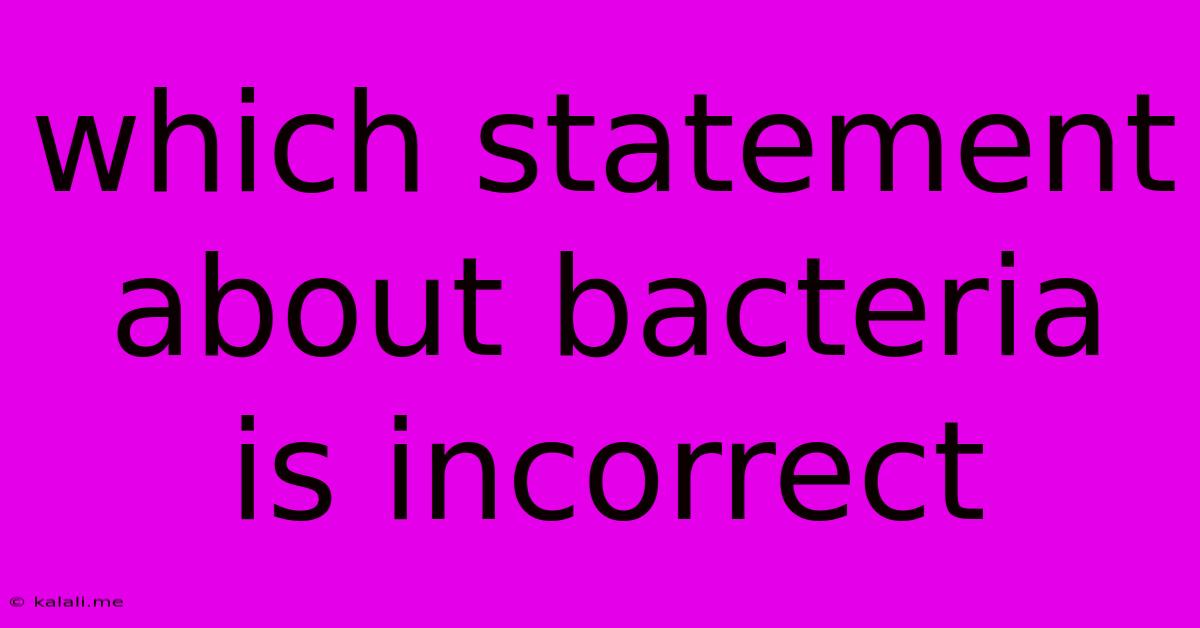Which Statement About Bacteria Is Incorrect
Kalali
Jun 14, 2025 · 3 min read

Table of Contents
Which Statement About Bacteria is Incorrect? Debunking Common Misconceptions
Bacteria are ubiquitous, single-celled microorganisms that play crucial roles in various ecosystems, from the human gut to the deep ocean. However, many misconceptions surround these tiny life forms. This article will explore common statements about bacteria and identify the incorrect one, clarifying the true nature of these fascinating organisms. Understanding bacteria is vital for comprehending human health, environmental processes, and even advancements in biotechnology.
Understanding Bacterial Diversity and Function: Bacteria are incredibly diverse. They exhibit a vast range of metabolic capabilities, enabling them to thrive in extreme environments and contribute significantly to nutrient cycling. Some bacteria are beneficial, aiding digestion or producing essential substances, while others are pathogenic, causing diseases. This diversity necessitates a nuanced understanding of their characteristics, dispelling the inaccurate notions that frequently circulate.
Common Statements About Bacteria – Separating Fact from Fiction: Let's examine some common statements regarding bacteria and pinpoint the inaccurate one.
-
Statement 1: All bacteria are harmful. This is demonstrably false. While some bacteria are pathogenic and cause diseases like strep throat, tuberculosis, or cholera, the vast majority are harmless or even beneficial. Many bacteria aid digestion, produce vitamins, and contribute to nutrient cycling in the environment. For example, E. coli in the gut aids digestion, while Lactobacillus is used in yogurt production. The role of bacteria in the human microbiome is a testament to their beneficial nature.
-
Statement 2: Bacteria are only found in dirty environments. This is also incorrect. Bacteria exist everywhere – in soil, water, air, and on virtually every surface. They are incredibly adaptable and can survive in various environments, from the hot springs of Yellowstone National Park to the frigid depths of the ocean. Even seemingly sterile environments harbor bacterial communities. This wide distribution highlights the essential role bacteria play in maintaining the ecological balance.
-
Statement 3: Bacteria are prokaryotic cells lacking a nucleus and other membrane-bound organelles. This statement is correct. This is a key defining characteristic of bacteria. They lack a defined nucleus and other membrane-bound organelles like mitochondria and chloroplasts, unlike eukaryotic cells found in plants and animals. Their simpler structure is a crucial factor in their adaptability and rapid reproduction.
-
Statement 4: All bacteria reproduce asexually through binary fission. This statement is largely true, but contains a slight nuance making it potentially incorrect. While binary fission (splitting into two identical daughter cells) is the primary mode of reproduction for most bacteria, some bacteria can also exchange genetic material through processes like conjugation, transformation, and transduction. This horizontal gene transfer adds complexity and contributes to bacterial evolution and adaptation. Therefore, stating it's exclusively asexual is an oversimplification.
-
Statement 5: Bacteria are always resistant to antibiotics. This statement is incorrect. While antibiotic resistance is a growing global concern, it's not inherent to all bacteria. Many bacteria are susceptible to various antibiotics, and the development of new antibiotics and strategies to combat resistance is an ongoing area of research and development.
Conclusion: The Incorrect Statement
The statement that is incorrect, or at least an oversimplification, is Statement 4: All bacteria reproduce asexually through binary fission. While binary fission is the dominant mode of bacterial reproduction, the existence of horizontal gene transfer mechanisms demonstrates a more complex reality.
Understanding the diverse nature of bacteria, their essential roles in various ecosystems, and the ongoing challenges posed by antibiotic resistance is critical for informed decision-making in medicine, agriculture, and environmental stewardship. By dispelling inaccurate notions about these microorganisms, we can foster a more accurate and nuanced understanding of their critical contributions to the world around us.
Latest Posts
Latest Posts
-
The Basic Structural Unit Of The Nervous System Is The
Jun 14, 2025
-
The Mid Atlantic Ridge Is An Example Of A
Jun 14, 2025
-
A Negatively Charged Ion Is Called A N
Jun 14, 2025
-
In Dna Thymine Always Pairs With
Jun 14, 2025
-
Which Are Not Considered Greenhouse Gases
Jun 14, 2025
Related Post
Thank you for visiting our website which covers about Which Statement About Bacteria Is Incorrect . We hope the information provided has been useful to you. Feel free to contact us if you have any questions or need further assistance. See you next time and don't miss to bookmark.